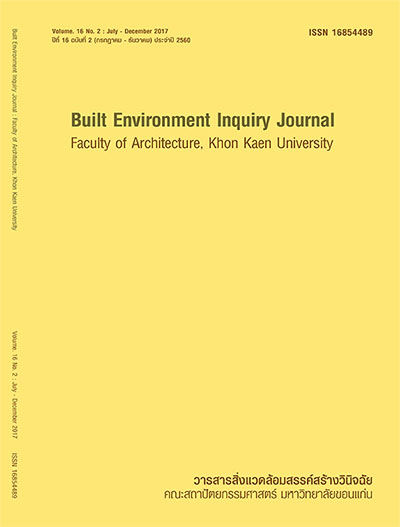แนวทางการออกแบบสิ่งอำนวยความสะดวกเพื่อคนทั้งมวลในอุทยานแห่งชาติ - Guidelines of Facilities design for All in National Park
คำสำคัญ:
การออกแบบเพื่อคนทั้งมวล, สิ่งอำนวยความสะดวกอุทยานแห่งชาติ, Universal Design, National Park Facilities, Design Guidelineบทคัดย่อ
บทคัดย่อ
งานวิจัยนี้มีวัตถุประสงค์เพื่อเสนอแนวทางการแบ่งเขตพื้นที่อุทยานแห่งชาติเพื่อออกแบบสิ่งอำนวยความสะดวกเพื่อคนทั้งมวล โดยประยุกต์แนวคิดช่วงชั้นโอกาสด้านนันทนาการ ที่เน้นจำแนกพื้นที่ตามประสบการณ์ที่นักท่องเที่ยวควรได้รับ ผสานการออกแบบเพื่อคนทั้งมวลให้คนทุกกลุ่มใช้พื้นที่ได้ โดยการวิเคราะห์ข้อมูลทุติยภูมิ สรุปตัวบ่งชี้การจำแนกเขตช่วงชั้นโอกาสทางนันทนาการ ใช้แบบสอบถามผู้สูงอายุ 341 คน คนพิการ 71 คน และใช้แบบสำรวจอุทยานแห่งชาติ 22 แห่ง เพื่อสรุปสถานการณ์สิ่งอำนวยความสะดวกเพื่อคนทั้งมวลในอุทยานแห่งชาติ สรุปแนวทางการออกแบบและตรวจทานโดยผู้ทรงคุณวุฒิ 8 ท่าน ผลการวิจัย เสนอการแบ่งเขตพื้นที่อุทยานแห่งชาติสำหรับออกแบบสิ่งอำนวยความสะดวกเพื่อคนทั้งมวลตามประสบการณ์ที่ควรได้รับและระดับการพัฒนา เป็น 3 ระดับ คือ 1.ระดับการออกแบบในพื้นที่ธรรมชาติสันโดษ เน้นอนุรักษ์ธรรมชาติ จำกัดการเข้าถึงและปริมาณผู้ใช้งาน ไม่มีการจัดสิ่งอำนวยความสะดวก 2.ระดับการออกแบบในพื้นที่ธรรมชาติกึ่งพัฒนา สามารถจัดสิ่งอำนวยความสะดวกได้ตามความจำเป็น เน้นกลมกลืนกับธรรมชาติ 3.ระดับการออกแบบในพื้นที่ที่มีการพัฒนา ให้เน้นอำนวยความสะดวกแก่คนทุกกลุ่มให้ปลอดภัยและเท่าเทียมแต่กลมกลืนกับธรรมชาติ
Abstract
This research aims to present management and design guidelines in national park for all by applying the concept of Recreation Opportunity Spectrum (ROS) that emphasize categorizing areas which traveler gain valuable experiences when they visit to recreation areas. In addition, these guidelines combine the concepts of Universal Design: UD with process of study and content analysis. This research applies and develops criteria for indicator the concept of Recreation Opportunity Spectrum (ROS) also use survey form in 12 National Parks in order to summary the current situation of facilities provided for persons with disabilities and the elderly in National Parks. The design guideline conclusion reviewed by 8 peers. As the results, the researcher found suggestion of Recreation Opportunity Spectrum (ROS) which classify by experience of user and level of development at 3 levels as follows: 1. Design for primitive areas- the area is limited to access and do not allow develop all facilities. 2. Design for intermediate natural areas- the area is allowed to develop facilities (if necessary) 3. Design for development areas- the area is allowed to harmony develop with nature, convenience and accessibility for all.
ดาวน์โหลด
เผยแพร่แล้ว
รูปแบบการอ้างอิง
ฉบับ
ประเภทบทความ
สัญญาอนุญาต
ทัศนะและข้อคิดเห็นของบทความที่ปรากฏในวารสารฉบับนี้เป็นของผู้เขียนแต่ละท่าน ไม่ถือว่าเป็นทัศนะและความรับผิดชอบของกองบรรณาธิการ




